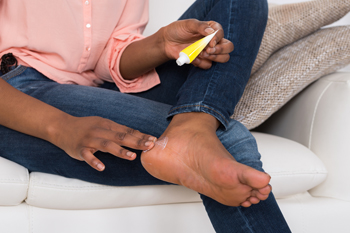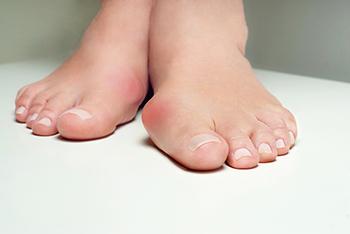3885 S. Decatur Blvd Suite #1080
Las Vegas, NV 89103

The bottom of the foot and the arch are common places to have foot pain. This can happen for a variety of reasons, including wearing shoes that do not fit correctly and standing on hard or uneven surfaces for most of the day. It is important to manage the pain by implementing specific techniques. Some people find relief by wearing insoles that can provide cushioning, in addition to wearing shoes that have ample support. Obesity may be a cause for foot pain to develop, and losing weight may help to reduce pressure on the soles of the feet. Performing gentle stretches may help to relieve foot pain, which may benefit the overall body. It is wise to temporarily stop any type of activity that may have caused the pain, in addition to frequently elevating the affected foot. If you have foot pain for any reason, it is suggested that you schedule an appointment with a podiatrist who can determine the cause and offer you the correct treatment options.
Foot Pain
Foot pain can be extremely painful and debilitating. If you have a foot pain, consult with Loren Hansen, DPM from Ankle & Foot Medical Center. Our doctor will assess your condition and provide you with quality foot and ankle treatment.
Causes
Foot pain is a very broad condition that could be caused by one or more ailments. The most common include:
Diagnosis
To figure out the cause of foot pain, podiatrists utilize several different methods. This can range from simple visual inspections and sensation tests to X-rays and MRI scans. Prior medical history, family medical history, and any recent physical traumatic events will all be taken into consideration for a proper diagnosis.
Treatment
Treatment depends upon the cause of the foot pain. Whether it is resting, staying off the foot, or having surgery; podiatrists have a number of treatment options available for foot pain.
If you have any questions, please feel free to contact our office located in Las Vegas, NV . We offer the newest diagnostic and treatment technologies for all your foot care needs.

Some foot conditions are mostly mild. This is to say that certain afflictions of the foot are not always accompanied by severe symptoms. Cracked heels are one such affliction of the foot. Many cases of cracked heels are mild, where fissures form on the back of the heel in an unsightly, yet mild, manner. However, there are some other cases of cracked heels that may be more severe for some patients. For example, some cases of cracked heels can result in painful sensations at the back of the heel. More severe cases of cracked heels might result in bleeding in this area. Persistent itching could also be another more severe symptom associated with cracked heels. If you are someone who is currently suffering from cracked heels, it is suggested that you contact a podiatrist today for more information and treatment.
Cracked heels are unsightly and can cause further damage to your shoes and feet. If you have any concerns, contact Loren Hansen, DPM from Ankle & Foot Medical Center. Our doctor can provide the care you need to keep you pain-free and on your feet.
Cracked Heels
Cracked heels appear unappealing and can make it harder for you walk around in sandals. Aside from looking unpleasant, cracked heels can also tear stockings, socks, and wear out your shoes. There are several methods to help restore a cracked heel and prevent further damage.
How Do You Get Them?
Dry skin is the number one culprit in creating cracked heels. Many athletes, walkers, joggers, and even swimmers suffer from cracked heels. Age and skin oil production play a role to getting cracked heels as well.
Promote Healing
Over the counter medicines can help, especially for those that need instant relief or who suffer from chronic dry feet.
Wear Socks – Wearing socks with medicated creams helps lock in moisture.
Moisturizers – Applying both day and night will help alleviate dryness which causes cracking.
Pumice Stones – These exfoliate and remove dead skin, which allows for smoother moisturizer application and better absorption into the skin.
Change in Diet
Eating healthy with a well-balanced diet will give the skin a fresh and radiant look. Your body responds to the kinds of food you ingest. Omega-3 fatty acids and zinc supplements can also revitalize skin tissue.
Most importantly, seek professional help if unsure how to proceed in treating cracked heels. A podiatrist will help you with any questions or information needed.
If you have any questions, please feel free to contact our office located in Las Vegas, NV . We offer the newest diagnostic and treatment technologies for all your foot care needs.

Infection, swelling, and pain can accompany an ingrown toenail. Genetic reasons may cause this foot condition, or it may happen from wearing shoes that are too tight. An ingrown toenail is defined as the nail growing into the skin instead of over it, and generally affects the big toe. It may also develop from cutting the toenails incorrectly, or if there has been a foot injury. An ingrown toenail that is first noticed may feel better when the foot is soaked in warm water for several minutes. This can make it easier to gently pull the nail away from the skin by using a small piece of cotton. Severely infected nails are often treated by a podiatrist who can accurately diagnose this condition and offer helpful prevention methods. If you are afflicted with an ingrown toenail, it is suggested that you consult a podiatrist who can prescribe medication and possibly perform minor surgery needed for permanent relief.
Ingrown toenails may initially present themselves as a minor discomfort, but they may progress into an infection in the skin without proper treatment. For more information about ingrown toenails, contact Loren Hansen, DPM of Ankle & Foot Medical Center. Our doctor can provide the care you need to keep you pain-free and on your feet.
Ingrown Toenails
Ingrown toenails are caused when the corner or side of a toenail grows into the soft flesh surrounding it. They often result in redness, swelling, pain, and in some cases, infection. This condition typically affects the big toe and may recur if it is not treated properly.
Causes
You are more likely to develop an ingrown toenail if you are obese, have diabetes, arthritis, or have any fungal infection in your nails. Additionally, people who have foot or toe deformities are at a higher risk of developing an ingrown toenail.
Symptoms
Some symptoms of ingrown toenails are redness, swelling, and pain. In rare cases, there may be a yellowish drainage coming from the nail.
Treatment
Ignoring an ingrown toenail can have serious complications. Infections of the nail border can progress to a deeper soft-tissue infection, which can then turn into a bone infection. You should always speak with your podiatrist if you suspect you have an ingrown toenail, especially if you have diabetes or poor circulation.
If you have any questions, please feel free to contact our office located in Las Vegas, NV . We offer the newest diagnostic and treatment technologies for all your foot care needs.

A bunion can be caused for various reasons, including genetic factors, aging, and choosing shoes that do not have enough room for the toes to move freely in. Wearing tight shoes may cause a bony protrusion on the side of the big toe, which may push the other toes toward each other. The medical term for a bunion is referred to as hallux valgus, which is considered a deformity. Protruding bunions may cause pain and pressure, and medical attention is often sought for relief. Calluses and corns may form on top of the toes due to the foot touching the top or side of the shoe. Prevention methods for bunions can be implemented by wearing shoes with adequate room in the toe area, and walking barefoot can help to strengthen the overall foot. If you have developed a bunion, it is suggested that you schedule an appointment with a podiatrist who can offer you additional relief options.
If you are suffering from bunion pain, contact Loren Hansen, DPM of Ankle & Foot Medical Center. Our doctor can provide the care you need to keep you pain-free and on your feet.
What Is a Bunion?
Bunions are painful bony bumps that usually develop on the inside of the foot at the joint of the big toe. As the deformity increases over time, it may become painful to walk and wear shoes. Women are more likely to exacerbate existing bunions since they often wear tight, narrow shoes that shift their toes together. Bunion pain can be relieved by wearing wider shoes with enough room for the toes.
Causes
Symptoms
In order to diagnose your bunion, your podiatrist may ask about your medical history, symptoms, and general health. Your doctor might also order an x-ray to take a closer look at your feet. Nonsurgical treatment options include orthotics, padding, icing, changes in footwear, and medication. If nonsurgical treatments don’t alleviate your bunion pain, surgery may be necessary.
If you have any questions, please feel free to contact our office located in Las Vegas, NV . We offer the newest diagnostic and treatment technologies for all your foot care needs.